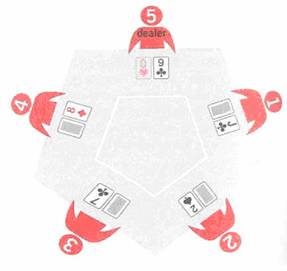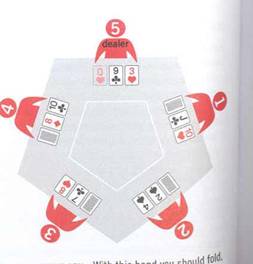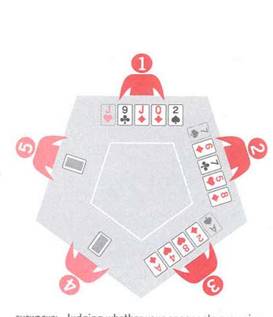EXAMPLE FIVE-CARD STUD BASIC HAND 2
Suppose you are player 5 with the hand shown. Betting limits are as before.
First betting interval
- The highest card on the table is a Jack, held by player 1 and he bets a chip.
- Player 2 calls.
- Player 3 calls.
- Player 4 calls the bet and raises two. Why? He either has an 8 in the hole, making a pair, or an Ace, or he is bluffing. You cannot see another card to equal your Queen, so you call.
- Players 1,2 and 3 also call, to end the first betting interval, in which all five of you have contributed three chips to a healthy pot of 15 chips. You must assume now that players 1,2 and 3 must all have either a pair, or an Ace or King in the hole, be poor players or be bluffing.

AFTER THE FIRST DEAL Pay careful attention to other poker players bets to get clues about their hole-cards.
Second betting interval
What are your options after the second deal? The only justification for staying in would be if all checked, indicating that none has improved, or better still, if only player 4 bet (say two chips). You are reckoning him for a pair of 8s. By receiving a Queen or 9 in your last two cards (so far as you know the remaining Queens and 9s are still in the pack, so the odds are about 5 to 2 against), you could be in with a shout. It would not be bad play to raise player 4 the maximum. You would need to put in four chips and there are already 17 in the pot. The other might then fold on the grounds that your 9 was paired after all. However, if any of players 1,2 or 3 bet again after being raised in the first round, you should fold. To continue would simply be throwing good money after bad.

AFTER THE SECOND DEAL With this hand you should fold, especially if more than one opponent bets.
Five-card Stud, High-Low
The procedure is as for regular Five-card Stud, with each player dealt a hole-card followed by four face-up cards, with a betting interval following each round of face-up cards. The ranks of hands are as in High-low Draw Poker. At the showdown, players use colored chips to declare whether they are contesting for the high or low pot.
EXAMPLE HIGH OR LOW?
Even with four of the five cards in each hand showing, it is not always clear whether those in a showdown should call high or low.
PLAYER 1
Your hole-card is ♥ J. You have a pair of Jacks. Should you call high or low? Player 2 is sure to be lower than you unless he has a straight, when he could be high and low. If he hasn’t a straight, he might call low. Player 3 looks as if he could be going for low but might have a pair of aces. Since player 2 is most likely low, you call high.
PLAYER 2
You too could be high or low. Has either player 1 or 3 completed a pair? If both, you are likely to be low; if neither , you are certainly high, with a pair of 7s. If only one has, you are unlikely to be either high or low. On the grounds that player 1 was unlikely to stay so far without a pair, you decide to call low.

SHOWDOWN Judging whether your opponents are going high or low is vital for success at High-Low Stud.
PLAYER 3
You are sure you have player 1 beaten for high, but cannot beat him for low. But has player 2 a straight for high or a near-certainty for low? You doubt he has completed a straight, and go high.
Player 2 wins half the pot for low ( he doesn’t need to show his gambling card, as he is the only low), player 3wins the other half of the pot for high, after a showdown with player 1.
